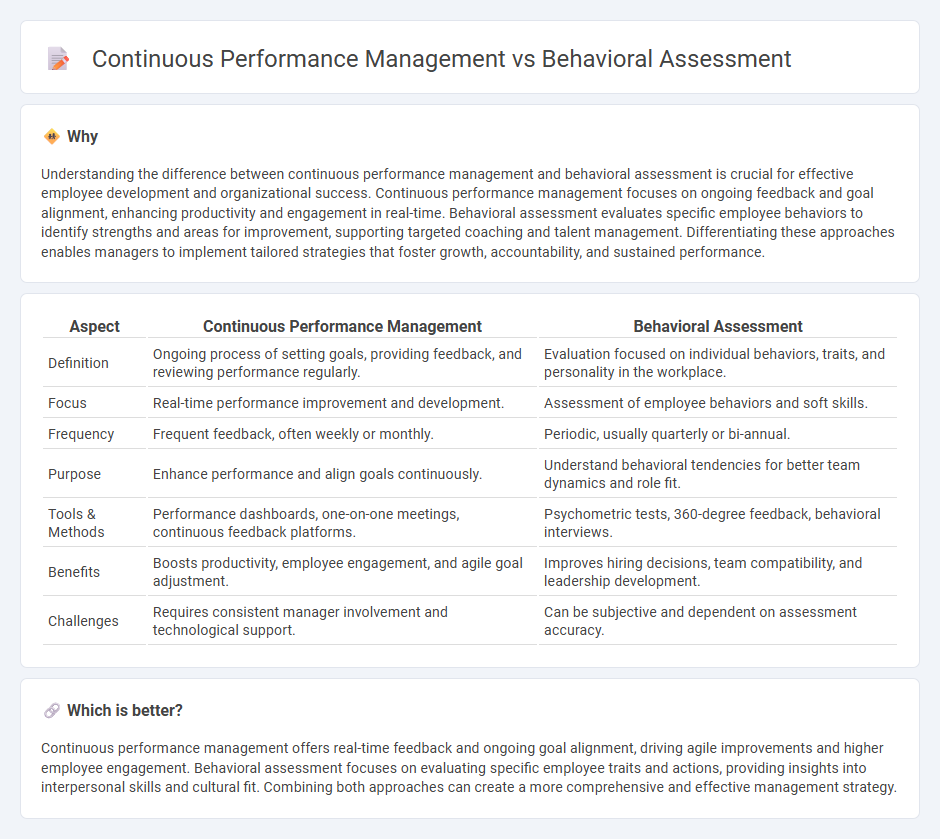
Continuous performance management focuses on real-time feedback and ongoing goal alignment to enhance employee productivity and engagement. Behavioral assessment evaluates individual actions and traits to understand work habits and predict future performance. Explore these approaches to discover how they can transform your organization's talent management strategy.
Why it is important
Understanding the difference between continuous performance management and behavioral assessment is crucial for effective employee development and organizational success. Continuous performance management focuses on ongoing feedback and goal alignment, enhancing productivity and engagement in real-time. Behavioral assessment evaluates specific employee behaviors to identify strengths and areas for improvement, supporting targeted coaching and talent management. Differentiating these approaches enables managers to implement tailored strategies that foster growth, accountability, and sustained performance.
Comparison Table
| Aspect | Continuous Performance Management | Behavioral Assessment |
|---|---|---|
| Definition | Ongoing process of setting goals, providing feedback, and reviewing performance regularly. | Evaluation focused on individual behaviors, traits, and personality in the workplace. |
| Focus | Real-time performance improvement and development. | Assessment of employee behaviors and soft skills. |
| Frequency | Frequent feedback, often weekly or monthly. | Periodic, usually quarterly or bi-annual. |
| Purpose | Enhance performance and align goals continuously. | Understand behavioral tendencies for better team dynamics and role fit. |
| Tools & Methods | Performance dashboards, one-on-one meetings, continuous feedback platforms. | Psychometric tests, 360-degree feedback, behavioral interviews. |
| Benefits | Boosts productivity, employee engagement, and agile goal adjustment. | Improves hiring decisions, team compatibility, and leadership development. |
| Challenges | Requires consistent manager involvement and technological support. | Can be subjective and dependent on assessment accuracy. |
Which is better?
Continuous performance management offers real-time feedback and ongoing goal alignment, driving agile improvements and higher employee engagement. Behavioral assessment focuses on evaluating specific employee traits and actions, providing insights into interpersonal skills and cultural fit. Combining both approaches can create a more comprehensive and effective management strategy.
Connection
Continuous performance management integrates real-time feedback and goal tracking, closely aligning with behavioral assessment by constantly evaluating employee actions and competencies. This dynamic approach enables managers to identify strengths and areas for development, fostering personalized growth and enhancing overall organizational performance. By linking ongoing performance data with behavior patterns, companies can create targeted interventions that drive sustained employee engagement and productivity.
Key Terms
**Behavioral Assessment:**
Behavioral assessment evaluates employee actions, skills, and competencies through structured observations and psychological tests to identify strengths and areas for improvement, enhancing workforce quality. Continuous performance management tracks ongoing employee performance via real-time feedback and goal-setting tools to foster agile development and productivity. Explore comprehensive insights into behavioral assessment to optimize talent development strategies effectively.
Observation
Behavioral assessment involves systematic observation to evaluate specific actions and reactions over a set period, often used to identify patterns and measure predefined behaviors. Continuous performance management focuses on ongoing observation, feedback, and adjustments to improve employee performance in real-time, leveraging frequent check-ins and data tracking. Discover more about how these observational approaches enhance workplace effectiveness.
Rating Scales
Behavioral assessment utilizes rating scales to quantitatively measure specific actions and traits, providing detailed insights into employee performance and behavioral patterns over time. Continuous performance management integrates these rating scales into ongoing feedback loops, enabling real-time adjustments and development planning for enhanced productivity. Explore the differences in rating scale applications to optimize your performance evaluation system.
Source and External Links
Types of behavior assessments - Understood.org - Behavioral assessments are tools used to identify and understand patterns and causes of children's behaviors, often involving questionnaires and observations from parents and teachers to help develop intervention plans.
What Is A Behavioral Assessment? Guide and Examples - Behavioral assessments examine an individual's behavior patterns, thoughts, emotions, and motivations, commonly used by employers as digital pre-screening tools to gauge job suitability and identify strengths and weaknesses.
What is a functional behavioral assessment (FBA)? - Understood.org - A functional behavioral assessment (FBA) is a structured process schools use to pinpoint the reasons behind challenging student behaviors and create targeted intervention plans to promote positive change.
 dowidth.com
dowidth.com